Neck Sharpies: The Back Side of Power

Things that happen against Rutgers’s defense can’t be taken too seriously. They’re playing a former Brady Hoke cornerback as a SAM in a 4-3 under, which means he’s taking on fullbacks and pulling guards. Their other edge guy is Kemoko Turay, an athletic dude who’s still rather unfamiliar with the game of football, and who’s functioning now as a WDE/OLB hybrid. Their WLB is by some distance the worst player I’ve scouted this year. One of their safeties is 5’9” and was their leading receiver last year and just joined the defense three weeks ago. The other safety is worse.
But their three interior DL are pretty stout. This made the Rutgers game uniquely suited to Michigan’s power running game. You know Power, Michigan’s base play under Jim Harbaugh, Brady Hoke, Lloyd Carr, and Fielding H. Yost. God’s play. Power.
Power and its close cousin Counter Trey are a lot like Inside Zone in that as a base play there are a ton of ways to run it depending on what the defense is showing and who appears where.
The concept is simple enough: 1) Block down on as many line defenders as you can to seal them inside, 2) Pry open a gap between them and the playside edge protector, and 3) Swing around a backside blocker into the point of attack to hit the first guy he sees. Win those downblocks and kick out the edge and now it’s just a race to see if your meat and the ball can get through that gap before the defense can plug it.
On “Power” the swing man is usually your backside guard, while a fullback or H-back is the “trapper” or pry-bar trying to blow the edge open. On “Counter Trey” those guys swap jobs. Note the backfield action is like a run to the right side, and that the pulling guard is wiping out the edge:
Counter Trey. (The guy Ben Mason blocked into the endzone is an awful, awful player, but still: braaaaawwwwrrrr!)
[Hit THE JUMP for what Rutgers did, and how Michigan didn’t have to respond because an answer was built into the play did I tell you this is God’s play?]
-------------------------------------
RUTGERS KNEW THIS WAS THE PLAN
As predicted when we did the scouting on these guys, it was clear to both teams that Michigan was going to run a ton of Power and Counter. That allowed Michigan to negate the three interior linemen by regularly blocking down on them. That put the success of the plays on how well Michigan’s guards and fullbacks could dislodge Turay and Douglas, and push the linebackers around.
So what do you if you’re Rutgers and don’t want this to happen?
SLANT!
SLANT!
On both of these Kugler could do a better job—the slant merely took away the advantage he got from his downblock and made it a fair fight. Still, by negating that advantage, the defense is winning back the matchup battle, giving their good DTs a chance to beat a block and make a play in the backfield.
Rutgers was pretty determined to take power away from the get-go. This below is the game’s second snap and Michigan’s first power run of the day. Before you hit play notice that the defense is baiting Michigan to run to this very spot, with a huge gap between their playside DE and the nose tackle (who’s head up on Kugler):
I drew it so you can see where everybody’s assignment ends up:
The good news is the blockers all adjusted properly. Gentry (red) correctly read that the DE was slanting inside and stayed with him, not getting a seal but creating plenty of space to run by on the left edge. Poggi (green) flared out to meet Rutgers’s edge protection and found a cornerback to set the other side of that hole.
The rest of the story is the guards and the running back versus the linebackers. Onwenu (purple) had nobody over him and released but because of the defensive playcall the WLB was already scraping over toward the hole; he would show up unblocked to make the tackle. The slant-scrape action also meant the MLB met the puller, Bredeson (blue) right smack in the middle of the gap.
So Rutgers invited this by offering a big wide gap (the space between red and green). But with the LBs pursuing so hard to the frontside, by the time the play develops there are two linebackers in that gap with one lead blocker to deal with them. Higdon can only run into the WLB and let momentum get the first down.
Or can he?
-------------------------------------
CUTTING TO THE BACK SIDE
If you’re wondering if a backside cut is part of power running, why yes it is. Because coaches like control a lot of them teach running backs how to read power like “A-B-C” i.e. read the gaps from the inside-out. With power running however, you’re more likely to get a huge mass of moving bodies in front of you. Power running is like zone running in that patience is rewarded. And part of that patience is, indeed, checking first for that backside cut.
That’s not such a simple thing to learn. As a running back you’re highly invested in the point of attack, which defenders are going where, and how those blocks are going. Taking your eyes off of this interesting stuff to see if a guy getting blocked down actually got blocked down is tedious. But it can also be rewarding, and with Rutgers slanting so often in this game it became doubly so.
By the fourth quarter Michigan was hitting that backside cut with regularity off of Power…
…and Counter.
And backside counter:
And counter versus weird run fits:
Watch LB #6 overreact to the pull; this was his gap.
These big cutback lanes were open because Rutgers was slanting their defensive line frontside and Michigan was adjusting on the fly. The backs just have to see the slant and they’ll know the cutback lane is open. This is where all that inside zone training helps: the backside guys might lose a downblock to a heavy slant, but can keep riding that dude and open up a lane behind him. Any linebackers who read the pull and jumped playside of a releasing playside OG are now totally wrongsided.
The guard (or the fullback on a Counter play) as a “hit whatever you see first” dude can adjust as well. On the two Evans runs above, Ben Mason saw a slanting DT was making it past the downblocks and used himself up to seal that backside lane.
Like inside zone, the offense’s ability to adjust Power runs on the fly makes it a play you can use all day…or at least until the defense starts activating the safeties against it and blitzing linebackers into gaps the defensive line doesn’t have covered. Provided the offense has a semi-functional passing game* to punish that, a good Power team can run to the ends of the Earth.
-------------------------------------
* [
Hey BP, BP, won’t you smile for me?]
-------------------------------------
FLIPPING THEM OFF
The other thing Michigan did to counter the slanting was to balance the line with heavy and goal line formations. Now the defense has a choice to make: do you slant to the side with the tight end, or the side with the other tight end? If you choose incorrectly…
#17 made a business decision.
Here’s how this unfolded:
Going with a balanced line also made it possible to flip Rutgers from an advantageous position to not that. After the first quarter the defense decided to hell with fancy crap: let’s put our 5-tech over a friggin’ guard. Michigan was like: “fine, we’ll go the other way.”
ahhhhhhhhh, trap-bam, thank you ma’am
Motioning Gentry across here flipped the strength of the formation. But the line didn’t shift, meaning Rutgers has found themselves facing a goal line formation with an over front.
This works despite Onwenu blocking nobody, partly because the WLB (I told you that guy isn’t good) got too far outside while setting the edge and missed an ankle tackle as Kareem ran by him.
-------------------------------------
GETTING GOOD
You have to wonder what Bredeson thought there by passing up the WLB. Standard coaching procedure would say hit the first guy who shows. The WLB is the first guy who shows, and Bredeson is like “Nah, you Upham.”
And this is totally correct. Rather than jamming up the lane with himself and the WLB, Bredeson gets himself clear through the hole and hits a safety. Kareem Walker blows by the WLB’s tackle attempt. Kareem is big. The WLB is bad at football, set up too far outside, and not worth the mess of a hallway fight.
Some teams that run power are trying to wall guys off. Others are focused on blowing dudes off the line. The great power teams however are those that can do a ton of different things on the fly. I can’t tell you this for certain but I bet Bredeson was in the film room one day and Drevno pointed out that sometimes you can do this sort of thing. Getting to that film room session however takes running power so many times that the coach doesn’t have to worry about adding more thought processes to the all-important basics.
Michigan’s swing blockers were passing up shots at these funnel defenders all day. So were outside blockers. Receivers routinely went for crack blocks on safeties (or linebackers) and left their cornerbacks to try to take out Michigan’s running backs alone. When they can get a block on those guys it opens up huge gainers.
Watch Schoenle (#81 top of the screen):
The difficult part is getting to the point where the players are so used to running it that they are making the correct adjustments mid-play: you have to get past “Where’s my block?” before you can get to “Kareem can beat that guy.”
Michigan’s offense put on a power clinic against Rutgers. That’s both expected and encouraging, since the things that should work against Rutgers most of the time ought to work against a real Big Ten defense a fair amount of the time. Michigan’s power running game looks like it’s there. They’re good enough now that if the defense has to play them honest—nerfing slants with backside cuts, formation flips, and varied blocks (e.g. Counter Trey), and keeping the safeties and linebackers from coming up too hard with a passing game that won’t routinely screw itself—Michigan’s power runs can be a consistent gainer.
November 1st, 2017 at 11:53 AM ^
a backside power
November 1st, 2017 at 12:15 PM ^
I do wonder on the first play you diagramed where he did NOT go to the backside if that's somewhat by design given that we needed a yard for a first down. In that situation there might be more of an emphasis on "follow your blocks, bury your head into the line, get a yard." Just an idea....and one the Lions could use a lesson on.
Otherwise this is a great post that gets into the details to show signs of encouragement. It would be easy to say "we only won 35-14 and not 78-0....clearly we suck" instead of seeing these nuances. I do think we're building toward an interior OL and group of TEs that will be a force in the future. Still missing the OTs though.
Finally, I do worry that we've spent a lot of time this week relative to Peters and the running game throwing around superlatives after beating Rutgers. Progress is great, but MSU and PSU made all of this look bad with their aggressive S and LB added to talented DLs. I'll feel better after solid performances the next two weeks heading into a rock fight with Wisconsin. Still feel hopeless against OSU though.
November 1st, 2017 at 1:05 PM ^
Yeah. I am personally holding out hope that it was Michigan's striking inability to pass that enabled State and PSU to play so aggressively against the run, and that M can put together enough stuff in the passing game to give us a shot against OSU. Seeing what they did to Penn State late, though, is not encouraging.
Ultimately I think it really depends on how our defense does that day. If the Penn State game was a one-off aberration and they hold OSU to ~ 20, then I think M will have a shot. If the D really is a year away, then it will be a long afternoon.
November 1st, 2017 at 2:01 PM ^
2nd and 1 isn't a "let's get the first down" situation and from what I've watched of Higdon he's not a "if the first down's there I'll take it" guy even on 3rd downs.
I do suspect that the weird play they ran a few times where they're running a trap and doubling the frontside DE and folding the backside tackle inside is drawn up to reliably get at least 1 yard and possible break for a bazillion. They ran it on 2nd and 1 twice before running it on 4th and 1. And I think they ran it again later on 2nd and 1.
November 1st, 2017 at 12:33 PM ^
Minnesota - #82
Maryland - #49
Wisconsin - #17
Ohio State - #1
Michigan State is #7, for what it’s worth.
November 1st, 2017 at 12:38 PM ^
November 1st, 2017 at 12:48 PM ^
I always look forward to these posts. Really helps to learn the game and what they are trying to accomplish. Hopefully, Peters can keep throwing the ball well and reading well, it will make the power game even more effective.
November 1st, 2017 at 2:30 PM ^
so basically if we can't run power against the remainder of the teams on our schedule, seth lied to us and it's seth's fault.
November 1st, 2017 at 2:33 PM ^
#FIRESETH
November 1st, 2017 at 3:03 PM ^
Seriously. Great work. Thank you.
November 1st, 2017 at 3:32 PM ^
I love me some neck sharpies. I feel like I understand play designs much better after reading one of these outstanding items.
The area I feel like I could better understand is how "game plans" get assembled. If one of our contributors could walk through (at whatever level of detail they are prepared to cover) how a coordinator evaluates an opponent's team, and then "installs" an offense or defense to take advantage of that, I would be an avid reader.
Thanks for all you do.
November 1st, 2017 at 5:48 PM ^
That sounds cool but I'm not a coach and certainly not on Michigan's staff. The only examples I can point you to are from Bo's era. One was Greg Dooley did an interview with Bo's [not the] offensive coordinator Jerry Hanlon. Hanlon said they used the early part of the week for fundamentals and the coaches spent Sundays and Mondays pouring over film, then would meet on Monday night to get Bo's approval on their gameplan. The other is Dr. Sap's article from 2016 on the origins of the dime defense. The latter is the most instructive. It's then DBs coach Lloyd Carr recalling how Michigan installed the dime defense:
“My recollection is that we put it in on Wednesday. We would go over our run coverages on Monday. Tuesdays we would hit,” Lloyd Carr told me. With Friday practices being a walk-through session, the defense essentially had one or two days to get this defense down.In another section Carr talked about how he'd gone over every single play Purdue runs during film session except one (he ran out of time). It turned out to be a huge play (a bubble screen). Extrapolating, it seems at least in Bo's time the assistants got several days to go over film and develop a gameplan--the coordinators given considerable or total leeway. Meanwhile they'd coach fundamentals and coach out mistakes from last week. Tuesday the scout team would be running the opponent's plays, and Wednesday they would focus in on a few things from the playbook and practice them against the Scout team. Then they'd finish that on Thursday and Friday would be nailing down the details.
November 1st, 2017 at 6:39 PM ^
November 2nd, 2017 at 12:00 AM ^
There’s really several layers to gameplanning. To be honest, the off-season film review of your lower levels and varsity is critical and would provide you your baseline on information related to “what you’ve got”. I would imagine at the college level practice film provides a similar level of self-scouting.
Coordinators all have their own personalities in terms of scheme, but at the end of the day, lots of people use the same concepts, repurposed to fit their respective personnel (if you’re adaptable) and philosophy. From a scheme perspective, you develop your base offense off what you can do well, and then its about developing the counters and complements. In the pass game, we look at the film weve ammassed on our current year opponents in the spring and generally figure out what the defensive schemes each team is likely to deploy against us. Then you can lump your available concepts into such buckets as “man-beaters”, “cov-2 beaters”, “cov-3” beaters, etc etc. same with the run game. If you can predict the #s in the box and look for those stunt/slant tendencies, you could figure out how your offense will work best. if efficient, you should have a good idea of each opponent’s lineups and scheme pre-season. Then when you get to game week, you are simplify confirming or adjusting your plan based on the new evidence available.
Things you evaluate as part of a game plan:
- base coverage(s)
- box #’s in various personnel packages, formations and situations
- the opponents predicted adjustments to your formations based on previous opponents as well as your previous tape.
- pressure tendencies (down, direction, specific player, etc)
- situational personnel adjustments
- best players
- weakest links)
- ability to contain the edge / discipline
- your own self-scouting / ability to break tendency.
... and so much more... this is a black hole
My timeline as an offensive coordinator in a game week... (not including indi /drills... this is just general focus... and just for the offensive side of the ball).
Friday Night: GAME
Saturday Morning: Ice, Game Review, Light Lift, and Field Walkthrough of anything new, corrections or things to be dusted off based on high level projections of the next opponent. I love the saturday morning practices. Purges the game from friday and gets you focused on whats next.
Saturday/Sunday: coaches review next opponent film, meet Sunday evening as offensive/defensive units with the HC (we video conference now to make it less time intensive) and Coordinators will propose an initial pass at the gameplan as well as a schedule for installing the plan.
Monday: focus on blitz protection calls, quick game, 3step game, tricks, with red zone, 3rd and long, 2- minute drill, etc. outside sweeps, toss and fly sweep.
Tuesday: inside run game and RPO’s, screens and play action passes. Will get in some 3rd and short& goalline situations (including backed up on our own goalline)
Wednesday: (generally tuesday night we make any updates to our plan and develop our script) run through our 10 play script ( plays weve identified that we think will put the opponent in a bind) and any other plays “off the band” that we want in our back pocket against a particular defense. Nail down any different personnel packages and work on changing in and out of those packages. We will work on starting drives from our own 20 out to midfield, sudden change in opponent territory, etc
Thursday: walk through of first 10 and any tricks or new additions added for the week. In and out of personnel packages.
Anyway, this could actually be much more in depth, but hopefully this gives you one perspective. Keys are making sure your scout team is really organized and giving the right looks in the right situations (which takes lots of prep and actual time to thoroughly break down the opponents D).
Fyi: We are a spread, no huddle team that likes to vary tempo. Generally 10 or 20 personnel ( not a fan of forcing tight ends that dont exist at the high school level - that said, its truly a wonderful thing to have a difference maker at TE.)
Anyway, cheers if youve made it through this..l
November 2nd, 2017 at 8:17 AM ^
This is very helpful. At some point in the future, I hope someone puts on his/her coordinator goggles and does an addendum to a Fe Fi Foe Film, saying this particular play we run should be featured in our game plan because it will do this to what the opponent is doing.
November 1st, 2017 at 4:24 PM ^
Thank you for the lesson, let's hope we take another step against Minn!
November 2nd, 2017 at 4:51 AM ^
Please note that the "Cutback" was to pretty much over the middle where the ball was snapped originally. That will happen when the defense overpursues to the playside. In the one clip, that created a huge wall on one side, and Evans reacted accordingly.
November 2nd, 2017 at 10:36 AM ^
That was some pretty ugly defensive play in those clips. Not sure what Rutgers was trying to do. Will be interesting (and probably more instructive) to see how Michigan does against some better defenses.
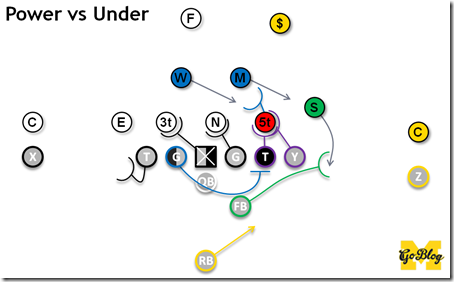
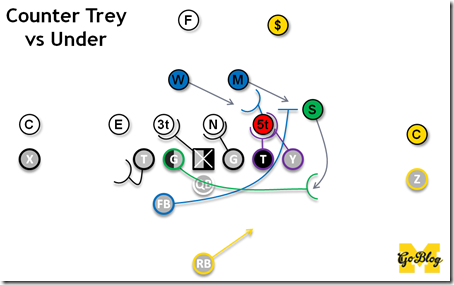
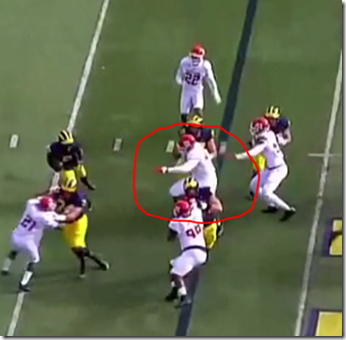
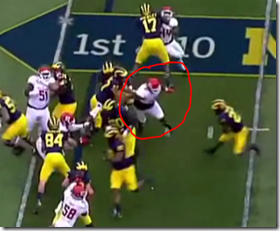

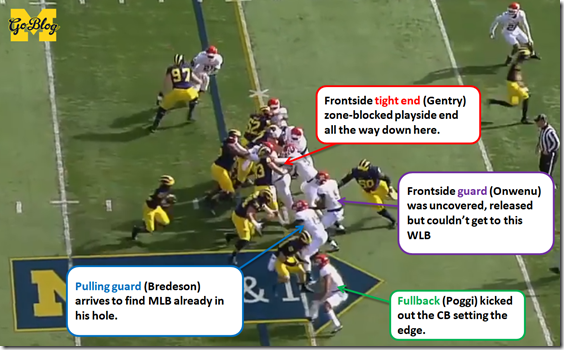
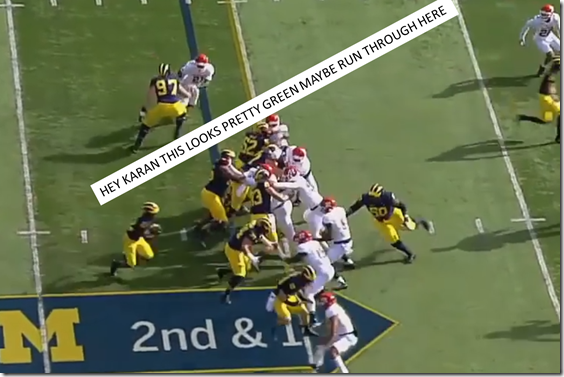


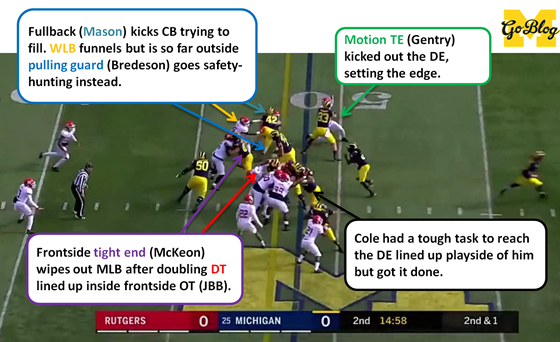
Comments